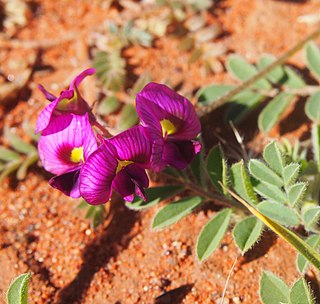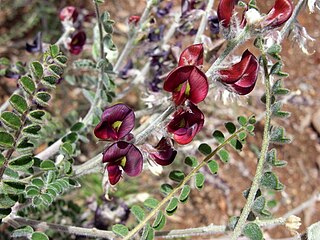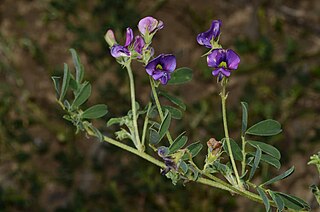
Swainsona behriana, commonly known as Behr's swainsona, is a species of flowering plant in the family Fabaceae and is endemic to south-eastern continental Australia. It is a prostrate or low-growing perennial herb with imparipinnate leaves usually with 9 to 13 narrowly elliptic to egg-shaped leaflets with the narrower end towards the base, and racemes of 2 to 7 purple flowers.
Swainsona acuticarinata is a species of flowering plant in the family Fabaceae and is endemic to arid areas of central Australia. It is a prostrate perennial herb with imparipinnate leaves with 5 to 11 leaflets, and racemes of purple flowers.

Swainsona brachycarpa, commonly known as slender swainson-pea, is a species of flowering plant in the family Fabaceae and is endemic to eastern Australia. It is a prostrate or ascending perennial herb with imparipinnate leaves usually with 9 to 13 egg-shaped to narrowly elliptic or egg-shaped leaflets, and racemes of up to 12 white, purple or dark red flowers.

Swainsona burkei is a species of flowering plant in the family Fabaceae and is endemic to northern Australia. It is a prostrate or perennial subshrub with imparipinnate leaves usually with 5 to 11 oblong to narrowly egg-shaped leaflets, and racemes of 5 to 10 purple flowers.

Swainsona burkittii, commonly known as woolly Darling pea, is a species of flowering plant in the family Fabaceae and is endemic to inland Australia. It is an erect or low-lying perennial with imparipinnate leaves usually with 15 to 30 egg-shaped to more or less circular leaflets, and racemes of up to fifty dark reddish-purple flowers.
Swainsona calcicola is a species of flowering plant in the family Fabaceae and is endemic to north-western Western Australia. It is a prostrate or ascending, low-growing perennial with many stems, imparipinnate leaves usually with 7 to 11 broadly egg-shaped leaflets with the narrower end towards the base, and racemes of usually 4 or 5 pink, purple or red flowers.
Swainsona cyclocarpa is a species of flowering plant in the family Fabaceae and is endemic to northern inland areas of Australia. It is a prostrate or low-growing annual with imparipinnate leaves usually with up to 7 usually egg-shaped leaflets with the narrower end towards the base, and racemes of 4 to 16 purple flowers.
Swainsona disjuncta is a species of flowering plant in the family Fabaceae and is endemic to widely separated areas of central Australia. It is a prostrate perennial herb with imparipinnate leaves with 3 to 9 egg-shaped leaflets, and racemes of purple, pink or red flowers in racemes of 3 to 15.

Swainsona elegans is a species of flowering plant in the family Fabaceae and is endemic to Western Australia. It is a prostrate or ascending annual with imparipinnate leaves, usually with 7 to 15 egg-shaped or elliptic leaflets, and racemes of up to 15 blue or reddish-purple flowers.
Swainsona fissimontana is a species of flowering plant in the family Fabaceae and is endemic to inland areas of southern continental Australia. It is a compact, erect or upright perennial herb with imparipinnate leaves with 7 to 13 narrowly elliptic to elliptic leaflets, and racemes of pink to dark purplish flowers in racemes of 3 to 11.
Swainsona fraseri is a species of flowering plant in the family Fabaceae and is endemic to eastern Australia. It is a perennial plant with imparipinnate leaves with mostly 21 to 24 ellipitic leaflets, and racemes of 20 or more pink to purple flowers.
Swainsona gracilis is a species of flowering plant in the family Fabaceae and is endemic to the south-west of Western Australia. It is a prostrate or ascending perennial herb with imparipinnate leaves with up to 15 wedge-shaped or narrowly oblong leaflets, and racemes of up to 4 purple or blue flowers.
Swainsona halophila is a species of flowering plant in the family Fabaceae and is endemic to inland areas of Western Australia. It is usually a prostrate annual herb with imparipinnate leaves with 9 to 13 egg-shaped to broadly wedge-shaped leaflets, and racemes of 2 to 9 purple flowers.
Swainsona kingii is a species of flowering plant in the family Fabaceae and is native to Western Australia and South Australia. It is a prostrate or ascending annual or perennial herb, with imparipinnate leaves with usually 5 egg-shaped leaflets with the narrower end towards the base, and racemes of 1 to 3 pink to purple flowers.

Swainsona laciniata is a species of flowering plant in the family Fabaceae and is endemic to north-western Australia. It is a prostrate or ascending perennial herb with imparipinnate leaves with 7 to 13 broadly elliptic to broadly egg-shaped leaflets, and racemes of 3 to 8 purple flowers.
Swainsona leeana is a species of flowering plant in the family Fabaceae and is endemic to the south-west of Australia. It is a small prostrate perennial, possible perennial with imparipinnate leaves with 5 to 7 broadly egg-shaped or elliptic leaflets, and racemes of up to 3 purple or yellow flowers.
Swainsona luteola is a species of flowering plant in the family Fabaceae and is endemic to the eastern Australia. It is a prostrate or low-lying to semi-erect perennial with imparipinnate leaves with usually 3 to 17 narrowly elliptic leaflets, and racemes of 5 to 15 purple, sometimes yellow flowers.
Swainsona microcalyx, commonly known as wild violet, is a species of flowering plant in the family Fabaceae and is endemic to southern mainland Australia. It is a prostrate or low-growing perennial herb, with imparipinnate leaves with 5 to 9 broadly egg-shaped to wedge-shaped leaflets and racemes of 5 to 15 purple flowers.

Swainsona oligophylla is a species of flowering plant in the family Fabaceae and is endemic to central Australia. It is usually a prostrate perennial plant with imparipinnate leaves with 5 to 7 egg-shaped leaflets, the narrower end towards the base, and racemes of 3 to 7 purple flowers.
Swainsona oliveri is a species of flowering plant in the family Fabaceae and is endemic to south-western Australia. It is a slender, prostrate to ascending annual or perennial herb with imparipinnate leaves with 9 to 13 narrowly egg-shaped leaflets, the narrower end towards the base, and racemes of up to 4 cream-coloured to yellow flowers, sometimes with a pink tinge.







